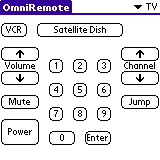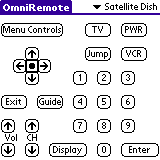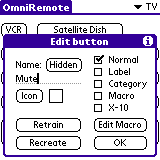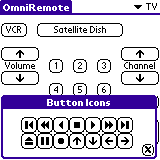Many years ago I got my first remote control TV. I thought, “Wow, using a remote
is cool!!”. Then I got a VCR. And a Satellite Dish. And a CD player. Etc…And along
with every new device, came another remote control. I have 5 remote controls stacked on
the book case in our family room. (OK, so remote number 5 is a broken one without
batteries for the kids to play with, but you get the picture 🙂
If you are like me, you eventually wind up with a quasi-universal remote- a universal
remote that controls almost all of the features, but for some reason, not everything. With
this in mind, I was a bit hesitant to test yet another universal remote control, the OmniRemote
Springboard Module, by Pacific Neo-Tek.
But I was very interested to give it a test drive, and I’m glad I did.
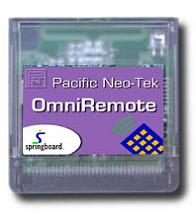
Ok, so the OmniRemote Springboard Module turns your Handspring PDA
into a universal remote. But there are some interesting differences that I think make it
better than the standard universal remote. First, universal remotes tend to have too many
buttons. Therefore, many of these types of remotes have very small buttons which are hard
to easily hit. Second, if they don’t have a lot of small buttons, then they have a
complicated way of toggling the few buttons they do have to do more than one function. On
these remotes, the buttons are never labeled exactly for everything you want them to do.
Finally, it’s not always easy to set the device code for your remote. In fact, I bought my
brother a SONY universal remote for Christmas, to replace his broken one, and we had to
call the “1-800” support number just to get the code.
So how is the OmniRemote Springboard Module different? Lets start with
setting the code. Rather than setting the code the way that a generic universal remote
would be done, which is by entering a 3 or 4 digit code directly in to the remote, the OmniRemote
senses the IR carrier frequency through the PDA IR port. Point the remote for whatever
device you are getting ready to train into OmniRemote at the PDA IR port.
Then go through the menu pick to train the device and hit any button on the device’s
remote. After a few seconds, OmniRemote will start your PDA beeping,
signaling that it has detected the frequency and you can now assign the function buttons.
This step needs to be done for each device you want to train into OmniRemote. The
cool thing about this is that you can set ANY remote control to a function on the
OmniRemote Springboard Module as long as it can be detected by the IR
port. (See below in the review on how I programmed my Jeep’s remote door lock.)
|
TV “category” screen |
Satellite “category” screen |
Once you have trained OmniRemote to pick up the signal on the device
remote, you can begin training the individual buttons. This was actually fun to do. There
are a few options that you have at this point. You can go with some of the standard device
setups that come with the product, or you can create your own. Remember when I mentioned
that some devices have too many buttons and they aren’t labeled properly, or perform
multiple functions? Well the next big difference between OmniRemote
and a generic universal remote is that the devices can all be kept separate through the
use of the Palm OS style “categories” pull down menu. Above are two screen
shots. The TV menu came with OmniRemote, and I added a button to take it
to the Satellite menu that I designed myself.
Whether you start with the supplied menus or design one of your own, you will need to
train the buttons using the edit menu. Here, you can change the button size, (Recreate),
assign the function from your device’s remote, (Retrain), assign the button to a category,
or create button icons. Once you have your menu buttons assigned properly, you can go to
the “move” menu and move them around in case you had some buttons too close to
each other.
|
The Edit menu |
The Icon button menu |
It’s also possible to set up macros and timers. I tested this by adding a button
“ALL OFF” to the TV menu, and assigned a macro to turn off the power of the TV
and satellite dish receiver. I also set a timer that would activate the “ALL
OFF” button at a certain time. Everything worked perfectly. It’s important when using
the timer function to make sure that the OmniRemote program was last
running when you turned off the PDA and set it down. If you had the Address Book open when
the timer was due start a macro, nothing would happen. Of course, you also need to make
sure the Springboard Module’s IR port is pointing at the device you want to operate.
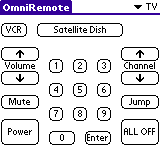
“ALL OFF” button added |
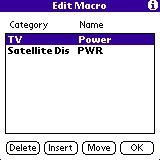
Macro window |
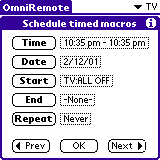
Timer window |
I need to mention that the OmniRemote capabilities are available in
two ways. You can use the Springboard Module version, or you can
just purchase the software and use it with the IR port on the PDA. To the best of my best
knowledge, the only difference in the two methods would be the range of the IR port. The
PDA IR port range is not very far. (They say anywhere from 2-25 feet, but 25 feet is a
stretch). In addition, the IR port is on the side of the PDA, so you would have to turn it
sideways to point it at the device. The range of the IR port on the OmniRemote
Springboard Module is much farther. I successfully tested it in my house at 35
feet away. That was as far as I could test it, but it probably would have gone
farther.
Also, although the OmniRemote Springboard Module installs the software
itself when the springboard module in inserted into the PDA, that software, at the time we
received the module they sent us, didn’t work with the Handspring Prism or Platinum. But
this isn’t an issue, because you can download the updated “remote.prc” file from
their web site. In fact, once you have either the licensed OmniRemote
software or the OmniRemote Springboard Module you are entitled to any and
all future version updates for free. In addition, the product comes with a help file that
is loaded when the unit is installed. I was able to use it to answer a few questions on
how to add labels and make macros. It’s easy to navigate and even has a “find”
function.
One of the cool features of the the OmniRemote Springboard Module is
that you can assign remote functions to the 6 buttons on the face of the PDA. I was able
to set my Jeep’s remote control door lock/security switch to the Memo button on my Visor.
It locked and unlocked the Jeep without any problem. (We got the car used, so we only had
one remote to lock the doors. Now we have two!) The only thing that you need to remember
in order to use the buttons on the PDA, is to make sure that the OmniRemote
program was running before you turned off the PDA. Other than the six buttons on the face
of the PDA, you would need to use the stylus. This could get annoying.
At $59.95, the price is a much higher than the cost of a generic universal remote. The
one I bought for my brother was only $14.95. But it didn’t do everything he wanted it to
do, and he had trouble setting it up. In addition, he could only control the devices it
was designed to work with, instead of a true universal remote like the OmniRemote.
I mean, could he have programmed his car’s remote with the SONY universal remote? Or
anything else that was not audio/video? I don’t think so. That function alone makes it
worth the price. Overall, the OmniRemote Springboard Module is a
well designed product, that does what it was designed to do quite well. In short,
it’s a great product.
Price: $59.95
Pros:
Great piece of software, and very user friendly.
Can program almost any device.
Comes with a good Help data base.
Offers more functionality than a generic universal remote.
Cons:
Stylus use could get tiresome for folks that channel surf.
Priced higher than other universal remotes.
Island with Palm Trees and Beach Vacation PopSockets MagSafe PopGrip for iPhone
$25.99 (as of 12/30/2025 08:06 GMT -06:00 - More infoProduct prices and availability are accurate as of the date/time indicated and are subject to change. Any price and availability information displayed on [relevant Amazon Site(s), as applicable] at the time of purchase will apply to the purchase of this product.)Summer Palm Tree Vacation Beach PopSockets MagSafe PopGrip for iPhone
$25.99 (as of 12/30/2025 03:50 GMT -06:00 - More infoProduct prices and availability are accurate as of the date/time indicated and are subject to change. Any price and availability information displayed on [relevant Amazon Site(s), as applicable] at the time of purchase will apply to the purchase of this product.)Product Information
| Price: | $59.95 |
| Manufacturer: | Pacific Neo-tek |
| Pros: |
|
| Cons: |
|

